 |
The big Aletsch Glacier

The Matterhorn in Zermatt is surely the most famous spot of Switzerland. As second, I want to mention the big Aletsch, with its surrounding mountains. The biggest glacier in the Alps is perfectly arranged with funiculars and mountain railways, so that it is possible to gaze at it from all sides, and it can be even accessed.
There are two famous, fabulous view mountains, from which one can enjoy a perfect view to the big Aletsch Glacier. From the place Fiesch, a gondola takes one in two stages to the nearly 3.000 m heighted Eggishorn. From the Grindelwald, one can get up to the Jungfraujoch that is approximately 2500 m higher, by rail. Both peaks are practically a march away from each other (across the glacier); but by car, half a day is needed to get from one place to the other, as the places Fiesch and Grindelwald are split from each other by the Alps.
With the Jungfraubahn to the Jungfraujoch
The rail trip from the Grindelwald to the little town Scheidegg and from there further to the Jungfraujoch is the second biggest tourist attraction of Switzerland. In this famous mountain railway, Japanese, Americans and other tourists are the majority. One gets in two stages to the highest located rail station of Europe. The attraction comes at a price: 75 € costs each ticket per person, rising continues. I took the first rail in the morning; this is a few euros cheaper, one has no to jostle and gets the best views from above.
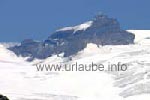
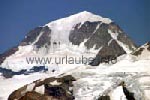
As Grindelwald is located at only 1.000 m height, but the Jungfraujoch at approximately 3.500 m height, it is recommendable to have a little break on the little Scheidegg (2.061 m), in order to get used to the altitude. From there, a mountain rail travels first through Wiesen until it continues through a tunnel of a length of 7 km. There are three stops at this stretch: the first stop leads one straight to the massive ice blocks of the Eiger Glacier. The train stops a second time in the middle of the tunnel. From a panorama window amidst the mountain, one has a great view to the glacier chunks down up to the Grindelwald. The third station, at a height of 3.160 m, is called Eismeer; here, the glacier breaks up; massive ice chunks with deep canyons are visible.
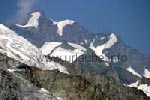
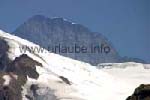
Once arrived at the highest station of Europe, some touristic offers are waiting for one that consist on tobogganing, skiing, a glacier grotto and of course a panorama-restaurant. But the most impressive are the views down to the Aletsch Glacier and the surrounding "Four-thousander" (this is the way a mountain is called with a height of more than 4.000 m) peaks. At a height of 3.573 m, it is also cold in the summer time; only those who have taken warm clothes to this place can unhurriedly enjoy the view and the glacier grotto for some hours. The Aletsch Glacier is visible flowing into its head area up to the big curve. This view is unforgettable, but the view from the Eggishorn is even more impressive.
With the gondola from Fiesch to the Eggishorn
By going from the Furka Pass down to the Rhônetal, at the place Fiesch, the Aletsch region begins. On a length of several kilometres, one place after the next invites to take a gondola up to the big Aletsch Glacier. There is no gondola with which one gets straight to the glacier, there is always to do a change, either at the Riederalp, the Bettmeralp or the Fiescheralp. Compared to the others, the driveway from Fiesch has the advantage that with approximately 2.900 m, one gets to the highest point at the south of the Aletsch Glacier. Moreover, there is a fantastic panorama view to enjoy from there by watching how the glacier, from the very top, curls around the Olmenhorn.

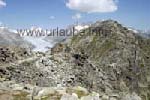
The drive way from Fiesch, that costs approximately 30 €, is of approximately half an hour. But one does not get to the peak of the Eggishorn heighted 2.926 m, but only to the lift and restaurant station. From there, a further quarter of hour is needed to get to the peak. But the way is not adequated for promenaders. A stony tightrope walk leads over to the peak and finally, on precipitous, stony paths to the peak (see picture). Thus, the access to the peak is only adequate for expert mountain climbers, that also wear the respective foot-wear.
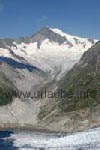
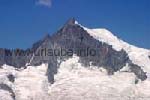
But one does not have to climb up the peak of Eggishorn; the views from the mountain restaurant are so dazzling that one cannot get enough of looking at it. Nearly the whole Aletsch Glacier is visible, from its head area in the Jungfrau region nearly up to the glacier snout in the Aletsch forest. Right in front of one, the 4.195 m heighted Aletschhorn appears that can be also discovered from the peaks of Zermatt. From the Aletschhorn, the Mittelaletsch Glacier flows down to the main glacier. Some time ago, the Mittelaletsch Glacier disembogued right at the big Aletsch Glacier; today, it continues melting upside and disembogues as an glacial stream in the main glacier.
By viewing the very top, at the point of origination of the glacier, one first has to make clear what is visible in detail: from the left to the right, one sees the famous peaks of the Jungfrau-Massive (4158 m), the Mönch (4099 m) and the Eiger (3970 m). Further into the right, one sees the highest peak of the Alps of Bern, the Finsteraarhorn (4274 m). Thus, together with the Aletschhorn (4195 m), one sees four of the 37 peaks of Switzerland higher than 4000 m ("Four-thousander"). But there's more to it than that; on a clear day, the Weisshorn (4506 m) in the Zermatt area is visible. And those who are very lucky with the weather and look deep into the distance, will even recognize the highest peak of the Alps, the Mont Blanc in the neighboured France.
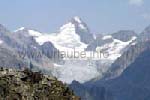
Quite a while up at the glacier is needed until one can take the view from the impressive Aletsch Glacier for the first time in order to look to the other directions. And if the Aletsch Glacier was not much enough, suddenly, one recognizes, at the other side of the Eggishorn peak, a further glacier with a gorgeous peak behind it: it is the 3637 m heighted Oberaarhorn with the Fiesch Glacier. One repeatedely sees this peak with its glacier by drinving alongside the Rhonetal.
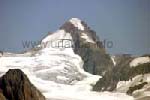
Actually, the Aletsch Glacier is much too good to be rapidly seen during a transit, that is to say, by getting up with the gondola, spoiling one's eyes for one or two hours, and getting down again. Because in the summer time, the Aletsch area is a huge hiking place and in the winter, it is, of course, a huge ski area. Thus, one could spend the whole holidays here. And of course, it is possible to enjoy the glacier much more by looking at it from all possible perspectives during some gorgeous hiking tours. And this is the only way to get to the glacier snout in the Aletsch forest, where the glacier water is retained in a big dam for the energy production.
Some information about the Aletsch Glacier
The Aletsch Glacier is the biggest Alp glacier of Europe. It is of a length of 23 km (decreasing trend) and covers a surface of 85 km². The glacier is fed with new snow in the Jungfrau-Massive and gets a thickness of 900 m at the Konkordia plaza. herewith, the Aletsch-Glacier is also the biggest sweet water reservoir of the Alps. Its amount of water would be enough to provide Germany potable water for one year.
At the lower end of the glacier tongue there is the Aletsch Forest with its aged Swiss stone pines and larches. Here, there is the glacier snout, where the milky glacier water pours out of the glacier and flows into the dam. In the year 2001, the whole Aletsch area was declared by the UNESCO to a world natural heritage.
Why does the Aletsch-Glacier have such strange lanes on its ice cap? They are medial moraines, thus rock masses, that the glacier carries with itself. A medial moraine is generated when two glaciers that have one side moraine each, converge. Thereby, the two side moraines band together to a medial moraine. This effect appears several times in the case of the big Aletsch Glacier. The merging of the edge moraines is even visible to the naked eye.

Back to the index Zermatt
Copyright: Patrick Wagner, www.tourist-guide.biz
|
 |